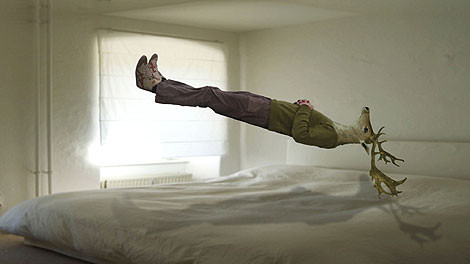Dimitris Tsoumplekas
14 Feb - 29 Mar 2008
DIMITRIS TSOUMPLEKAS
"Family Affairs"
14.02.08 – 29.03.08
In Family Affairs, Dimitris Tsoumplekas revisits the sites and landscapes of childhood and contemplates them through the eyes of the adult. In his photographs, videos and installations, the artist employs the language of fable and fairy tale to narrate allegorical tales of family life. Animals, incidents of transformation, secret dens in the woods, steaming pots: these are some of the symbols that allow him to comment on family legends and family trees, but also to offer some fundamentally autobiographical thoughts on the contemporary family – this small, idealized yet, in essence, rather menacing nucleus that is the architect of passions.
Continuing his investigations into the notion of space and the impact of architecture on our personal histories (enduring concerns of the artist that have mainly been expressed in solo exhibitions such as “Open Kitchen-Broken Homes” and “Satori in Maroussi”), Dimitris Tsoumplekas ultimately arrives at a sort of existential architecture that suggests we are not simply the residents of homes and neighbourhoods and cities, but more so the residents of our inner worlds. The idiosyncratic architecture of these internal landscapes recalls the faith placed in fairy tales by the Brothers Grimm; a faith in “those secret hideaways to be found in homes and backyards, passed down from grandfather to grandson, that now seem to be constantly making way to accommodate the need for more usable space in our new homes – the need for a kind of empty and foolish grandeur”.
As far as utility is concerned, the artist reserves his own definitions of a notion that has summarily been determined by advertising, the laws governing consumption and a set of so-called “imperative” needs: by combining the reality of family life (its frustrations, the violence of coming of age, the utopia of childhood) and fairy tale iconography (forests and towers, nightmarish Little-Red-Riding-Hoods and precocious children climbing upon a cloud), he reinvents utility as a lyrical, perhaps even futile luxury, which can however help name the world, and our place within it, anew.
"Family Affairs"
14.02.08 – 29.03.08
In Family Affairs, Dimitris Tsoumplekas revisits the sites and landscapes of childhood and contemplates them through the eyes of the adult. In his photographs, videos and installations, the artist employs the language of fable and fairy tale to narrate allegorical tales of family life. Animals, incidents of transformation, secret dens in the woods, steaming pots: these are some of the symbols that allow him to comment on family legends and family trees, but also to offer some fundamentally autobiographical thoughts on the contemporary family – this small, idealized yet, in essence, rather menacing nucleus that is the architect of passions.
Continuing his investigations into the notion of space and the impact of architecture on our personal histories (enduring concerns of the artist that have mainly been expressed in solo exhibitions such as “Open Kitchen-Broken Homes” and “Satori in Maroussi”), Dimitris Tsoumplekas ultimately arrives at a sort of existential architecture that suggests we are not simply the residents of homes and neighbourhoods and cities, but more so the residents of our inner worlds. The idiosyncratic architecture of these internal landscapes recalls the faith placed in fairy tales by the Brothers Grimm; a faith in “those secret hideaways to be found in homes and backyards, passed down from grandfather to grandson, that now seem to be constantly making way to accommodate the need for more usable space in our new homes – the need for a kind of empty and foolish grandeur”.
As far as utility is concerned, the artist reserves his own definitions of a notion that has summarily been determined by advertising, the laws governing consumption and a set of so-called “imperative” needs: by combining the reality of family life (its frustrations, the violence of coming of age, the utopia of childhood) and fairy tale iconography (forests and towers, nightmarish Little-Red-Riding-Hoods and precocious children climbing upon a cloud), he reinvents utility as a lyrical, perhaps even futile luxury, which can however help name the world, and our place within it, anew.

